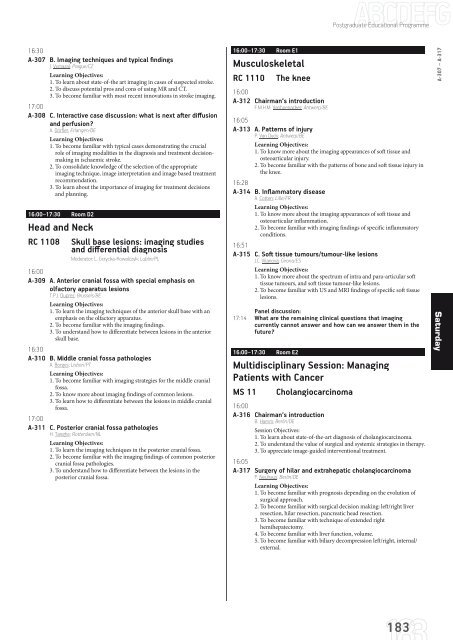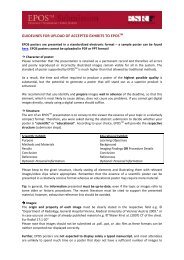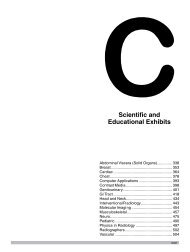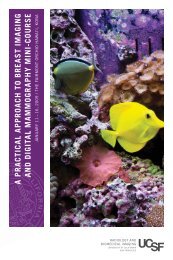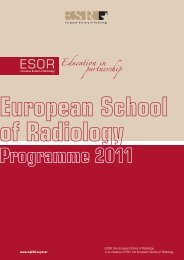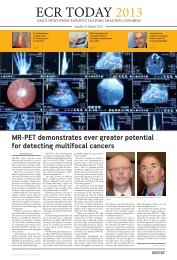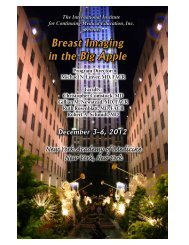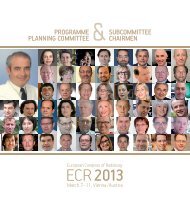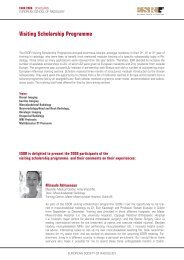ECR 2013 â Final Programme - myESR.org
ECR 2013 â Final Programme - myESR.org
ECR 2013 â Final Programme - myESR.org
- No tags were found...
Create successful ePaper yourself
Turn your PDF publications into a flip-book with our unique Google optimized e-Paper software.
Postgraduate Educational <strong>Programme</strong>16:30A-307 B. Imaging techniques and typical findingsJ. Vymazal; Prague/CZLearning Objectives:1. To learn about state-of-the art imaging in cases of suspected stroke.2. To discuss potential pros and cons of using MR and CT.3. To become familiar with most recent innovations in stroke imaging.17:00A-308 C. Interactive case discussion: what is next after diffusionand perfusion?A. Dörfler; Erlangen/DELearning Objectives:1. To become familiar with typical cases demonstrating the crucialrole of imaging modalities in the diagnosis and treatment decisionmakingin ischaemic stroke.2. To consolidate knowledge of the selection of the appropriateimaging technique, image interpretation and image based treatmentrecommendation.3. To learn about the importance of imaging for treatment decisionsand planning.16:00–17:30 Room D2Head and NeckRC 1108 Skull base lesions: imaging studiesand differential diagnosisModerator: L. Grzycka-Kowalczyk; Lublin/PL16:00A-309 A. Anterior cranial fossa with special emphasis onolfactory apparatus lesionsT.P.J. Duprez; Brussels/BELearning Objectives:1. To learn the imaging techniques of the anterior skull base with anemphasis on the olfactory apparatus.2. To become familiar with the imaging findings.3. To understand how to differentiate between lesions in the anteriorskull base.16:30A-310 B. Middle cranial fossa pathologiesA. B<strong>org</strong>es; Lisbon/PTLearning Objectives:1. To become familiar with imaging strategies for the middle cranialfossa.2. To know more about imaging findings of common lesions.3. To learn how to differentiate between the lesions in middle cranialfossa.17:00A-311 C. Posterior cranial fossa pathologiesH. Tanghe; Rotterdam/NLLearning Objectives:1. To learn the imaging techniques in the posterior cranial fossa.2. To become familiar with the imaging findings of common posteriorcranial fossa pathologies.3. To understand how to differentiate between the lesions in theposterior cranial fossa.16:00–17:30 Room E1MusculoskeletalRC 1110 The knee16:00A-312 Chairman‘s introductionF.M.H.M. Vanhoenacker; Antwerp/BE16:05A-313 A. Patterns of injuryP. Van Dyck; Antwerp/BELearning Objectives:1. To know more about the imaging appearances of soft tissue andosteoarticular injury.2. To become familiar with the patterns of bone and soft tissue injury inthe knee.16:28A-314 B. Inflammatory diseaseA. Cotten; Lille/FRLearning Objectives:1. To know more about the imaging appearances of soft tissue andosteoarticular inflammation.2. To become familiar with imaging findings of specific inflammatoryconditions.16:51A-315 C. Soft tissue tumours/tumour-like lesionsJ.C. Vilanova; Girona/ESLearning Objectives:1. To know more about the spectrum of intra and para-articular softtissue tumours, and soft tissue tumour-like lesions.2. To become familiar with US and MRI findings of specific soft tissuelesions.Panel discussion:17:14 What are the remaining clinical questions that imagingcurrently cannot answer and how can we answer them in thefuture?16:00–17:30 Room E2Multidisciplinary Session: ManagingPatients with CancerMS 11 Cholangiocarcinoma16:00A-316 Chairman‘s introductionB. Hamm; Berlin/DESession Objectives:1. To learn about state-of-the-art diagnosis of cholangiocarcinoma.2. To understand the value of surgical and systemic strategies in therapy.3. To appreciate image-guided interventional treatment.16:05A-317 Surgery of hilar and extrahepatic cholangiocarcinomaP. Neuhaus; Berlin/DELearning Objectives:1. To become familiar with prognosis depending on the evolution ofsurgical approach.2. To become familiar with surgical decision making: left/right liverresection, hilar resection, pancreatic head resection.3. To become familiar with technique of extended righthemihepatectomy.4. To become familiar with liver function, volume.5. To become familiar with biliary decompression left/right, internal/external.A-307 – A-317Saturday183


